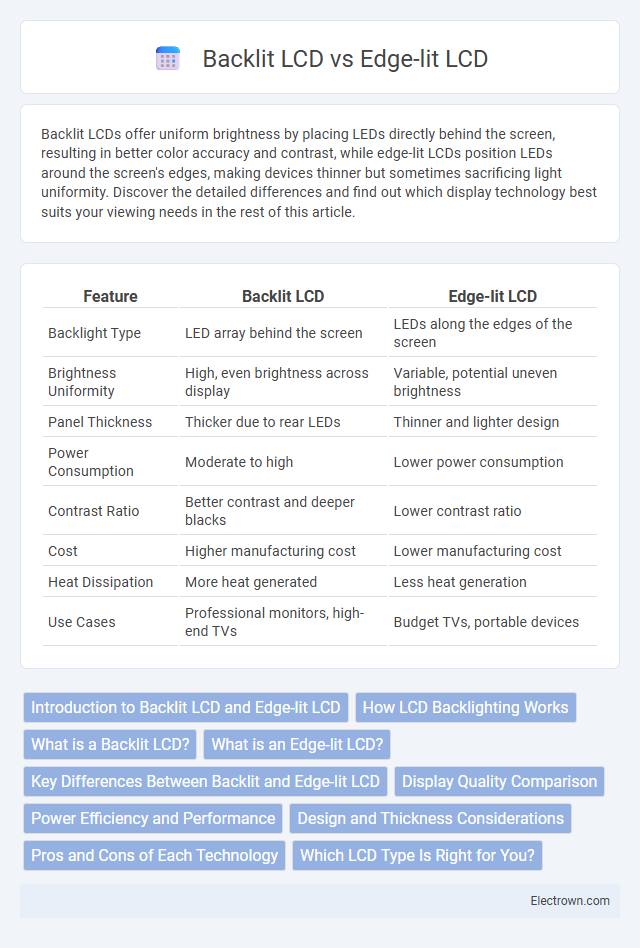Backlit LCDs offer uniform brightness by placing LEDs directly behind the screen, resulting in better color accuracy and contrast, while edge-lit LCDs position LEDs around the screen's edges, making devices thinner but sometimes sacrificing light uniformity. Discover the detailed differences and find out which display technology best suits your viewing needs in the rest of this article.
Table of Comparison
| Feature | Backlit LCD | Edge-lit LCD |
|---|---|---|
| Backlight Type | LED array behind the screen | LEDs along the edges of the screen |
| Brightness Uniformity | High, even brightness across display | Variable, potential uneven brightness |
| Panel Thickness | Thicker due to rear LEDs | Thinner and lighter design |
| Power Consumption | Moderate to high | Lower power consumption |
| Contrast Ratio | Better contrast and deeper blacks | Lower contrast ratio |
| Cost | Higher manufacturing cost | Lower manufacturing cost |
| Heat Dissipation | More heat generated | Less heat generation |
| Use Cases | Professional monitors, high-end TVs | Budget TVs, portable devices |
Introduction to Backlit LCD and Edge-lit LCD
Backlit LCDs utilize LED lights placed directly behind the display panel, offering uniform brightness and enhanced contrast ideal for high-quality visuals. Edge-lit LCDs position LEDs along the screen's edges, allowing thinner designs but sometimes resulting in uneven lighting and reduced contrast. Comparing these backlighting techniques highlights trade-offs between display thickness, brightness uniformity, and overall image quality.
How LCD Backlighting Works
Backlit LCD panels use an array of LEDs placed directly behind the screen to provide uniform and intense light, enhancing brightness and color accuracy. Edge-lit LCDs position LEDs along the edges, using light guides to distribute illumination, resulting in thinner designs but with potential for uneven brightness and lower contrast. The choice between these backlighting methods significantly impacts display performance, power consumption, and overall visual quality.
What is a Backlit LCD?
A Backlit LCD uses an array of LEDs positioned directly behind the display panel, providing uniform brightness and improved contrast across the entire screen. This design enhances image quality and offers better color accuracy compared to Edge-lit LCDs, where LEDs are placed only along the edges. Your viewing experience benefits from the consistent illumination that Backlit LCD technology delivers, making it ideal for detailed visuals and high-performance displays.
What is an Edge-lit LCD?
An Edge-lit LCD uses LEDs positioned along the edges of the screen to illuminate the display, creating a thinner panel design compared to traditional backlit LCDs. This lighting method allows for more energy-efficient screens with a slim profile, but can sometimes result in uneven brightness. Edge-lit technology is commonly used in modern flat-screen TVs and monitors to enhance form factor without significantly increasing manufacturing costs.
Key Differences Between Backlit and Edge-lit LCD
Backlit LCD screens use a full array of LEDs behind the entire display panel, providing uniform brightness and better contrast compared to edge-lit LCDs, which position LEDs only along the screen's edges. Edge-lit LCDs offer thinner designs and lower power consumption but may suffer from uneven brightness and reduced local dimming capabilities. Your choice between backlit and edge-lit LCDs should balance image quality needs against device thickness and energy efficiency preferences.
Display Quality Comparison
Backlit LCDs provide more uniform brightness and better contrast ratios due to their direct LED placement behind the screen, resulting in richer colors and deeper blacks compared to edge-lit LCDs. Edge-lit LCDs often struggle with uneven illumination and color consistency, especially around the edges, which can diminish overall picture quality. The superior backlighting technology in backlit LCDs enhances viewing angles and minimizes light bleed, making them ideal for high-definition content and gaming.
Power Efficiency and Performance
Backlit LCDs use direct LED arrays behind the screen, providing more uniform brightness and higher contrast, which improves visual performance but generally consumes more power. Edge-lit LCDs position LEDs along the screen edges, offering slimmer designs with better power efficiency but often at the cost of less consistent brightness and reduced contrast levels. Your choice between the two should balance the need for power savings with desired display quality, as backlit models enhance performance while edge-lit options favor energy efficiency.
Design and Thickness Considerations
Backlit LCDs use numerous LEDs placed directly behind the screen, resulting in a uniform light distribution but requiring a thicker panel design to accommodate the lighting array. Edge-lit LCDs position LEDs along the screen's edges, enabling a thinner and more lightweight display but sometimes causing uneven brightness across the panel. These design differences make backlit LCDs preferable for applications needing consistent illumination, while edge-lit models are favored for sleek, slim-profile devices.
Pros and Cons of Each Technology
Backlit LCDs offer superior brightness and uniform illumination, enhancing image quality in brightly lit environments, but they tend to consume more power and increase manufacturing costs. Edge-lit LCDs are thinner and more energy-efficient, making them ideal for slim designs, yet they may suffer from uneven brightness and reduced contrast compared to backlit models. Choosing between backlit and edge-lit LCDs depends on prioritizing image quality versus device thickness and energy consumption.
Which LCD Type Is Right for You?
Backlit LCDs provide uniform brightness across the screen, making them ideal for tasks requiring consistent color accuracy and high contrast, such as photo editing or professional graphic design. Edge-lit LCDs, with their slimmer profiles and energy efficiency, suit general users who prioritize sleek design and lower power consumption without demanding perfect brightness uniformity. Choosing the right LCD depends on your need for color precision versus the importance of device aesthetics and energy savings.
Backlit LCD vs Edge-lit LCD Infographic

 electrown.com
electrown.com